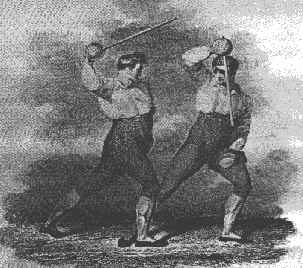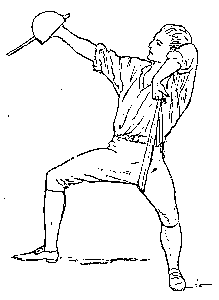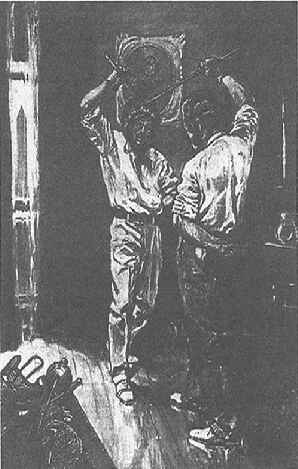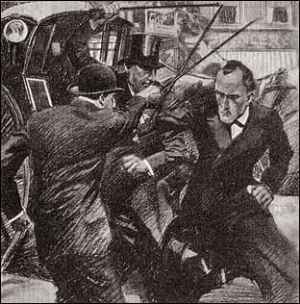
Picture courtesy of Westside Fencing Centre
By Tony Wolf

Singlesticks - wooden rods of about thirty-five inches in length, equipped with rigid guards which completely enclose the fencer's hand - were the 18th and 19th century descendants of Medieval wasters, wooden facsimile weapons popularly used for weapon training. These practice tools allowed a greater measure of safety, and were less expensive to replace, than steel swords. During the Georgian and Victorian eras, Singlestick play was popularly employed in prize-fights and tournament competitions, for which purposes it was sometimes also known as cudgelling or backswording. The weapon was also used as a substitute for the Naval cutlass and cavalry sabre during training exercises.
Singlestick fencing was widely practised throughout England, the British Commonwealth, and the U.S.A. until the early part of the 20th century, often in tandem with the other popular recreations of the salle d'armes, including foil, duelling-sword (epee), bayonet and quarterstaff fencing. Two annual English Singlestick competitions were instituted between 1880-1900; one held in June as part of the Grand Military Tournament, and the other hosted by the German Gymnasium in December. Thus, by the turn of the twentieth century, Singlestick fencing had become established as an internationally popular combat sport, drawing from the intertwined traditions of rustic cudgel-play, military drill and the private fencing academy.
The first decades of the twentieth century brought about the decline of Singlestick play. Tragically, many young athletes lost their lives in the Great War (1914-1919). Subsequent advances in technology allowed the mass-manufacture of relatively inexpensive, flexible and lightweight steel fencing blades, and in the 1920's the organisers of the Olympic Games selected three fencing sports - foil, epee and sabre - as Olympic events. As a result, many clubs began to focus exclusively on these forms of fencing, with sabre in particular coming to subsume a great deal of Singlestick practice and technique. The Great Depression of the 1930s and the Second World War in the '40s similarly diminished interest in obscure fencing methods, until the sport of Singlestick effectively became extinct.
1787: A set of singlesticks is visible in Rowlandson's etching of London-based fencing master Harry Angelo's Salle d'Armes
1790: The book Anti-Pugilism; or, The Science of Defence Exemplified In Short and Easy Lessons for the Practice of the Broad Sword and Single Stick Illustrated with Copper Plates By a Highland Officer details a system of stick play for use in self-defence.
1794: Despite having little or no experience with the use of the cavalry sabre, fencing master Harry Angelo is commissioned to develop a system of self defence instruction for the City of London Light Horse Volunteers, and bases his lessons on the use of the singlestick.
1806: A visitor to London's Saville House, which housed a diverse range of businesses, describes how "the click of Billiard-balls, the music of poses plastiques, the thwacking of single-sticks, the cracking of rifles, and the stamping of delighted Walhallaists, all mingle with each other, and it is only by taking refuge in the lowest apartment, which partakes of a coffee-room, a cabin, and a cellar, that you find repose."
1809: The poet Lord Byron holds a housewarming party. Host and guests slept in until one, and "the afternoon was passed in various diversions, fencing, single-stick: . . . riding, cricket, sailing on the lake."
1817: In a letter to Thomas Jefferson discussing plans for a University in the state of Virginia, architect William Thornton wrote:
Let all the Exercises be such as would tend to make great and useful men, and the military Exercises, fencing with the broad and small sword, boxing with mufflers, playing the single Stick, jumping, wrestling, throwing the Javelin and whatever tends to render men most athletic, at the same time that it tends to perfect them in what may eventually be of use, ought only to be permitted as sports in their leisure hours. Thus would I make men of active Bodies, as well as of extraordinary Minds.
1820: An illustration produced for Pierce Egan's popular serialised novel of the early 1820s, Life in London portrays Egan's characters "Corinthian Tom" and Jerry Hawthorn visiting the Bond Street fencing school. A rack of singlesticks is shown hanging on the far wall.
1838: Fencing master Harry Angelo is invested with the position of Naval Instructor in the Cutlass, and develops a training system employing singlesticks.
1840: Donald Walker publishes his book Defensive Exercises, including a chapter on singlestick fencing.
1847: Lord Barrington hosts a prize-fight between cudgelers at Shrivenham, Berkshire. The prize was £5 to the winner, with victory being awarded to the man who first drew blood from the other's head.
1857: A handbill for an English "Pastime" or sports and games festival, reads:
1stlyThat a pastime be held on the White Horse Hill, on Thursday and Friday, the 17th and 18th of September in accordance with the old custom at the time of " The Scouring of the Horse ".
2dly
That E. Martin Atkins, Esq, of Kingston Lisle, be appointed Treasurer.
3dly
That prizes be awarded for the following game and sports. That is to say-
Backsword Play Old gamesters £8
Backsword Play Young gamesters £4

In Tom Brown's Schooldays (1857) author Thomas Hughes recalled backswording as a rustic recreation of his youth in the 1820s:
The weapon is a good stout ash-stick with a large basket-handle ... The players are called "old gamesters," -why, I can't tell you,- and their object is simply to break one another's heads: for the moment that blood runs an inch anywhere above the eyebrow, the old gamester to whom it belongs is beaten, and has to stop. A very slight blow with the sticks will fetch blood, so that it is by no means a punishing pastime, if the men don't play on purpose, and savagely, at the body and arms of their adversaries.
The old gamester going into action only takes off his hat and coat, and arms himself with a stick: he then loops the fingers of his left hand in a handkerchief or strap which he fastens around his left leg, measuring the length, so that when he draws it tight with his left elbow in the air, the elbow shall just reach as high as his crown. Thus you see, as long as chooses to keep up his left elbow, regardless of cuts, he has a perfect guard for the left side of his head.

Then he advances his right hand above and in front of his head, holding his stick across so that its point projects an inch or two over his left elbow, and thus his head is completely guarded, and he faces his man armed in like manner, and they stand some three feet apart, often nearer, and feint, and strike, and return at one another's heads, until one cries 'hold,' or blood flows: in the first case they are allowed a minute's time, and go on again; in the latter, another pair of gamesters are called on. If good men are playing, the quickness of returns is marvelous; you hear a rattle like that a boy makes drawing his stick along palings, only heavier, and the closeness of the men in action to one another gives it a strange interest, and makes a spell at backswording a very noble sight.
1874: The Royal Madras Fusiliers stage a "Grand Assault at Arms" incorporating demonstrations of "broad(sword) and single stick fighting, mounted combat, bayonet and sword fencing, and gymnastics including the flying trapeze and vaulting".
1876: An exhibition of singlestick fencing is performed by members of the British Navy.
1882: Mounted and dismounted singlestick competitions are introduced at the Grand Tournament and Assault at Arms in Islington.
1883: An article in the Canadian Illustrated News notes that:
It is rather surprising that more use is not made of the smaller halls, meeting-rooms, ball-rooms, and lecture-rooms that are plentiful enough all over the city. They will not do for tennis; but they serve well enough for the practice of light gymnastics, fencing, broadsword, and single-stick exercise, and wrestling and boxing matches.
1885 - According to an article in the New York Times,
The foil, however, is the central exercise for all play with the single stick, broadsword, claymore, and quarterstaff, and, other things being equal, ought to teach men best the way to defend themselves against a single assailant or against odds.
1898: Broadsword and Single-stick, with Chapters on Quarter-Staff, Bayonet, Cudgel, Shillalah, Walking-Stick, and Other Weapons of Self-Defence", by R.G. Allanson-Winn and C. Phillipps-Wolley is published in London. Phillipps-Wolley's chapter on singlestick play is available online here.
1901: Captain Alfred Hutton, writing in his book the Sword and the Centuries, recalls an incident that took place in a London salle during the late 1850s;
The pair engaged; the sergeant led off in his customary violent fashion, but Mr. Rolland played in a manner that had never been seen before. This time he was serious. Usually he would lead off with a frank attack; now he was strangely quiet. He parried the furious blows, and only now and then replied with a riposte. T-y, fancying that this man was afraid of him, redoubled his energy, and gradually tired himself, which was exactly what his opponent intended he should do. At last the supreme moment arrived. Rolland all of a sudden crouched like a tiger, like a tiger sprang forward and with all the force of his spring and the weight of his mighty arm landed a fearful blow exactly on the point of the inside of his adversary's knee. The biter was bit. Sergeant T-y uttered a shriek of agony, and fell fainting on the floor. He was carried to the dressing-room, where they fomented his leg with hot water and did the best they could for him at the moment. He was taken in a cab to the hospital where he remained over a month, and it was three months before he was able to mount a horse again
1902: In a letter to Master James A. Garfield dated December 26, 1902, President Theodore Roosevelt wrote:

Late in the afternoon I played at single stick with General Wood and Mr. Ferguson. I am going to get your father to come on and try it soon. We have to try to hit as light as possible, but sometimes we hit hard, and today I have a bump over one eye and a swollen wrist.
1904: Albertson van Zo Post wins the singlestick gold
medal at the St. Louis Olympic Games
1912: American playwright Upton Sinclair publishes the Naturewoman, featuring a female singlestick fencer named Oceana who challenges several male characters to bout with the sticks. The full text is available here.
1924: In the Adventure of the Illustrious Client, Sherlock Holmes remarks to Dr. Watson:

I'm a bit of a single-stick expert, as you know. I took most of them on my guard. It was the second man that was too much for me.